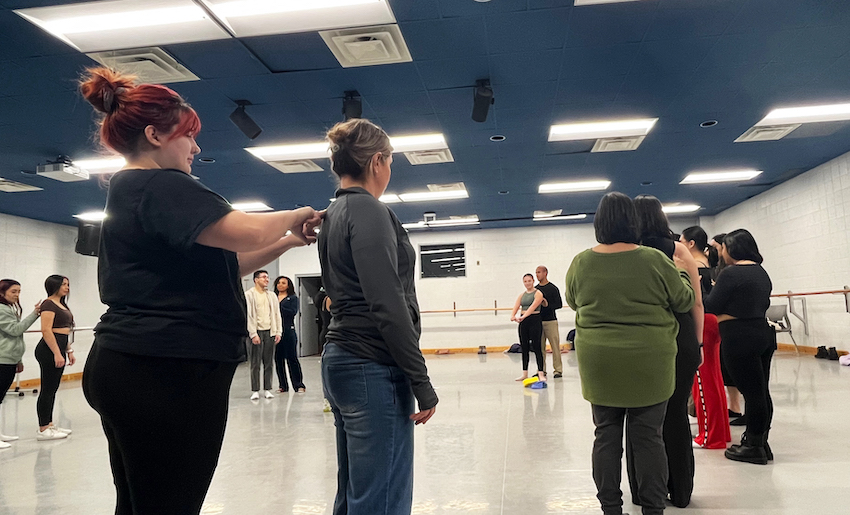
UTEP Researchers to Design Movement-Based Training to Support Local Health Providers
Program aims to ease burnout and related issues
EL PASO, Texas (Mar. 12, 2024) – Burnout among health care workers is a well-documented problem that can exacerbate health disparities and limit access to care.

Now, researchers at The University of Texas at El Paso are taking a creative approach in their search for a solution to this issue – a training program for providers that combines elements of art and science.
The project will examine the impact of a movement-based and somatics cross-training intervention on health care providers in the Paso del Norte region. It’s supported by a grant from the National Endowment for the Arts (NEA), and spearheaded by Melissa Melpignano, Ph.D., assistant professor of dance in the College of Liberal Arts. Amelia Rau, Ph.D., clinical assistant professor in the Speech-Language Pathology Program in the College of Health Sciences, is the grant’s co-principal investigator.
Somatics refers to a field of study and practice that explores the body-mind connection through sensory awareness. Examples of the practice include breathing exercises and stretching. By fostering mindful movement and holistic wellbeing, somatics promotes healing, self-awareness and improved overall health by empowering individuals, Melpignano said.
The aim of the UTEP research team is to create somatics and movement trainings for local health care providers, including physicians, nurses and other licensed medical professionals, which can include sets of 30-second to 1-minute exercises that providers can apply in their clinical settings, some even in tandem with their patient, to bring both individuals’ physical experience back into focus.
This awareness, Melpignano said, should help prevent or manage burnout in the provider, improve the patient-provider relationship and even contribute to better outcomes for patients.
“Our goal is to bring the health care and artistic ecosystems together without hierarchies to find methods with long-term impact to train providers in truly recentering the body as a site of listening, care and knowledge – not only of diagnosis – for themselves and their patients to collectively elevate the quality of life for the El Paso communities,” she said.
Some of the practices the researchers will test include choreographic exercises to reorganize clinical spaces, such as exam rooms, to foster more welcoming and effective patient-provider interactions; different breathing techniques; tapping, shaking, and sponging, which are somatic strategies that gently intervene on specific body parts and activate mental visualization and imagery to release tension or pain in the muscles.
Both Rau and Melpignano have begun implementing many of these strategies in their classrooms. Rau said she encourages her students to use movement as a tool for analyzing and coping with significant challenges in health care.
“These practices enable students to connect personally with challenging subjects and conversations beyond using words,” she said. “They also foster greater adaptability and compassion as we navigate health care scenarios.”
Ultimately, the researchers aim to create a new model of interprofessional training that can be applied anywhere outside the Paso del Norte region and adapted to specific contexts.
For this study, Melpignano and Rau will work with research partners in the Department of Pediatrics at the Texas Tech University Health Sciences Center and other health care institutions across the region, as well as with internationally renowned somatics and dance practitioners.
The bulk of the research will be based on data that will be collected during two sessions that will take place during the summers of 2024 and 2025. The researchers expect 15 to 20 health providers to participate in these week-long, intensive experiences that will include extended training and post-training reflection periods.
To support the work, the principal and co-principal investigators will engage students from dance and health sciences in the research process by employing two undergraduates and one doctoral student.
The total budget for the study is $50,000, which includes the NEA grant and matching funds from the colleges of Liberal Arts and Health Sciences.
About The University of Texas at El Paso
The University of Texas at El Paso is America’s leading Hispanic-serving university. Located at the westernmost tip of Texas, where three states and two countries converge along the Rio Grande, 84% of our 24,000 students are Hispanic, and more than half are the first in their families to go to college. UTEP offers 172 bachelor’s, master’s and doctoral degree programs at the only open-access, top-tier research university in America.
Last Updated on March 12, 2024 at 12:00 AM | Originally published March 12, 2024
By MC Staff UTEP Marketing and Communications
